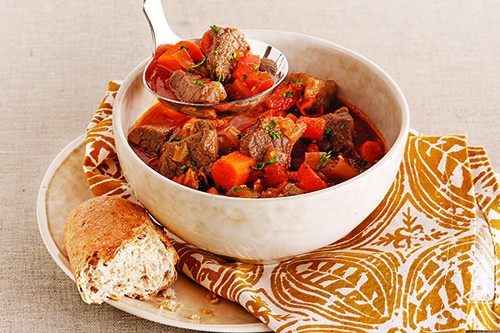
Considered one of the earliest domesticated animals, goat is consumed by more than 70 percent of the world's population, especially in many North African and Middle Eastern nations as well as in the Caribbean, Southeast Asia and developing tropical countries. Goat is commonplace for some ethnic populations in the United States, but only in the past decade has goat meat made its way into mainstream kitchens and recipes.
Goats are commonly raised for their milk, but certain breeds are superior for their meat, including Spanish goats and South African Boer goats. Breed aside, the goat's size and age affect its tenderness and flavor. The meat from yearling or younger goats is very lean because kid goats do not store much body fat, while older goats yield a less tender yet juicier and earthier-tasting meat. Younger and smaller goats have a milder flavor, often described as a cross between lamb and beef.
Because goat meat is so lean, it should be cooked slowly and at low temperatures to keep it tender and moist. Braising in liquid such as broth, wine or milk works well for shank, leg or shoulder cuts, especially in a slow cooker. Pressure cooking is an even faster way to braise while locking in flavor and tenderness. Cuts from the loin or rib are the most tender and can be marinated and then roasted in the oven, in a smoker or on the grill.
Goat in the Clinic
Classified as a red meat, goat meat ranges in color from light pink to bright red, depending on the goat's breed, age and gender. The meat from male goats is lighter in color and lower in fat, while female goat meat is more marbled and tender, making it better suited for steaks and chops. Compared to beef, pork and lamb, goat meat is lower in total fat, saturated fat, calories and cholesterol at 122 calories, 2.6 grams fat, 0.8 grams saturated fat and 64 milligrams cholesterol per 3-ounce roasted portion.
Goat meat is an excellent source of protein and zinc, a good source of iron, potassium and vitamin B12, and is low in sodium.
Goat in Quantity
Goat meat is inspected by the United States Department of Agriculture, but there are no quality or yield grades. Retail cuts of goat are similar to those for lamb or mutton. On menus, goat meat may be referred to as chevon when the meat comes from an adult goat, or cabrito, capretto or kid when from young goats.
In Latin dishes, it is often rubbed with chilies and spices and slow-roasted, or stewed for Mexican birria. Indian cooking uses goat meat in curries, biryanis and yogurt-thickened dishes. Greek and Southern Italian celebrations may include roasted baby goat, while curried goat is a Caribbean favorite. Goat meat can be substituted in almost any recipe that calls for lamb, beef or chicken, with cooking methods matched to the cut. It can be stewed, curried, baked, grilled, barbecued, minced, canned, fried or made into sausage or jerky.
Contrary to popular belief, goats are picky eaters with an appetite for shrubs and weeds that other livestock won't touch, making goat farming relatively easy on pasture land. Fresh goat meat is available from ethnic markets and specialty butchers. Frozen goat meat is more likely to be imported. For safety, raw goat meat should be handled similarly to other raw meats.
Cook ground goat meat to 160 degrees Fahrenheit and steaks, chops and roasts to a minimum internal temperature of 145 degrees Fahrenheit.
Betsy Hornick, MS, RD, LDN, is a food and nutrition communications consultant based in northern Illinois
Kabritu Stobá (Caribbean Goat Stew )
Recipe developed by Jessie Erwin, RD, LDN
Ingredients
1 pound boneless goat meat, chopped into 1-inch cubes
2 tablespoons canola oil
1 medium onion, chopped
3 medium carrots, peeled and sliced
3 cloves garlic, minced
1/4 cup tomato paste
2 cups beef or chicken stock
1/4 cup white wine or white vinegar
1/4 teaspoon ground nutmeg
1 teaspoon sugar
1/2 teaspoon red pepper flakes
Juice from 1 lime
2 medium tomatoes, chopped
Salt and pepper to taste
Chopped parsley (optional)
Directions
- Heat canola oil in a large skillet over medium heat, then add goat and brown for 5 minutes, turning cubes frequently.
- Add onions and carrots and sauté for 5 minutes or until carrots soften.
- Stir in garlic and cook for 30 seconds.
- Add tomato paste, stock, wine, nutmeg, sugar and red pepper flakes.
- Bring stew to a boil, then reduce heat, cover and simmer on low for 2 hours, adding more water or stock if necessary to keep the stew moist.
- Remove lid and add tomatoes and lime juice. Continue simmering for 15 to 20 minutes or until stew reaches desired consistency.
- Add salt and pepper to taste. Ladle into serving bowls and sprinkle with chopped parsley, if desired. Serves 4.
Nutrition Information
Serving size : 1 cup
Calories 312; Total fat 11g; Sat. fat 2g; Chol . 85mg; Sodium 515mg; Carb . 18g; Fiber 4g; Sugars 11g; Protein 36g; Potassium 1,248mg; Phosphorous 308mg
